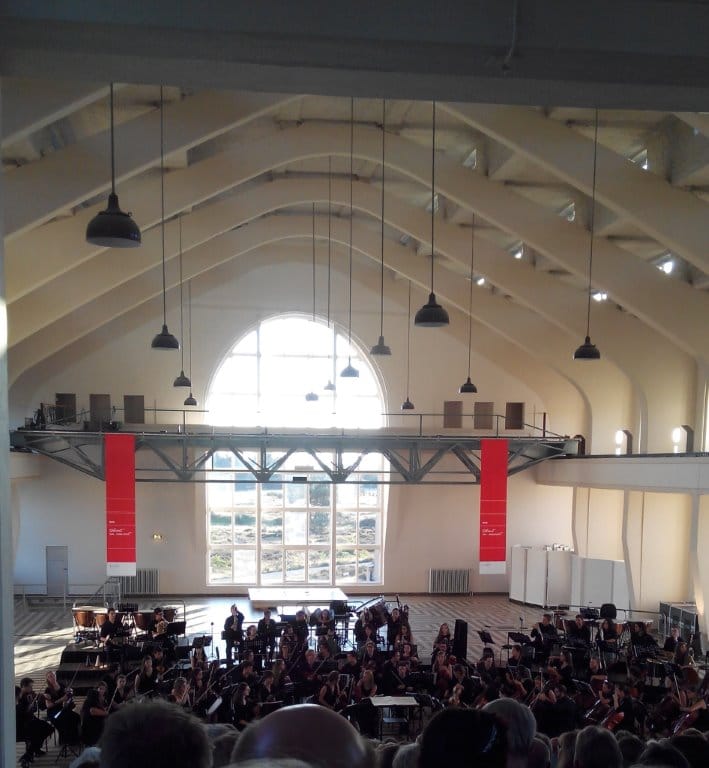Terwijl de jonge musici van het NJO Symfonieorkest vervaarlijke oorlogsklanken uitstoten, zien we achter hen twee kleuters onbevangen dartelen over de Veluwse hei. Ontroerend en tegelijkertijd o zo toepasselijk, want hoewel Carl Nielsen zijn overdonderende Vierde Symfonie tijdens de Eerste Wereldoorlog componeerde (1914-16), bleef hij overtuigd van het goede in de mens. Hij doopte haar Det Uudslukkelige, wat zoveel betekent als ‘het onuitblusbare’, waarmee hij doelde op het onuitroeibare doorzettingsvermogen van de mens.
De jonge Zweedse dirigent Christian Karlsen zweepte zijn honderdkoppig ensemble zaterdag 8 augustus op met grootse, maar beheerste gebaren en realiseerde een gloedvolle uitvoering, die de sfeervolle ‘kathedraal’ van voormalig zendstation Radio Kootwijk op zijn grondvesten deed schudden.
Gebouwd in 1923 en opgetrokken uit ongenaakbaar beton, past de imposante architectuur perfect bij Nielsens monumentale compositie. Temeer daar de schijnbaar onverbiddelijke buitenkant binnenin juist licht en luchtig blijkt te zijn, met sierlijke bogen en immense vensters, die uitkijken over een zacht welvend heidelandschap.
Zo bloeien ook onder het ruwe oppervlak van Nielsens symfonie geregeld zoetgevooisde, lyrische soli op, intens en gevoelvol uitgevoerd door de individuele strijkers en hout- en koperblazers. Ook de twee links en rechts achter het orkest opgestelde paukenisten glorieerden met goed getimede, oorverdovende donderslagen en onheilszwangere roffels.
Nielsens Vierde Symfonie blijft transparant
Ik ben eerlijk gezegd geen groot liefhebber van Nielsens soms wat al te bombastische klankwereld, maar Karlsen slaagde erin het weefsel transparant te houden, waardoor de compositie mij meer wist te overtuigen dan tijdens eerdere uitvoeringen. Ook in het grillige Vioolconcert van Karlsens landgenoot Anders Hillborg, en het nationalistische Finlandia van Jean Sibelius wisten dirigent en musici feilloos de goede sfeer te treffen.
Een prestatie van formaat, want het is geen sinecure in slechts enkele repetities een geheel uit studenten samengesteld orkest tot een eenheid te smeden. Natuurlijk, niet alle overgangen en inzetten verliepen vlekkeloos, maar die minieme uitglijders vallen in het niet bij de tomeloze inzet waarmee de musici zich van de eerste tot de allerlaatste lessenaar voor de muziek inzetten. Niks geen nine-to-five mentaliteit, zoals je vaak bij professionele orkesten aantreft. – Aantrof, beter gezegd, want nu zij het bezuinigingsvuur na aan hun schenen voelen, tonen orkestmusici de laatste jaren meer inzet.
Dat jongeren uit heel Europa naar Apeldoorn komen om zich drie weken lang in allerlei muziekstijlen en -genres te laten scholen, is hartverwarmend. Ik sprak in de pauze met de Spaanse tromboniste Vanessa Bailen Fuentes.
Soepel vioolspel van Joe Puglia
Solist in het Vioolconcert van Anders Hillborg was Joe Puglia (New York, 1984), bekend als concertmeester van het Asko|Schönberg. Hij speelde de razendsnelle en vaak hondsmoeilijke partij met overgave en superieure beheersing. Zijn soepele, warme toon klonk ook in de ijlste flageoletten loepzuiver. Opmerkelijk waren de vele glissandi, zowel van de solist als het orkest, waarbij door het gebruik van kwarttonen een soms spookachtige sfeer ontstond. Ik vroeg Puglia naar zijn mening.
Na afloop van het concert fietste ik terug naar huis door het allengs verduisterende bos, met de zinderende klanken en feeërieke locatie nog vers in mijn geheugen. Hoewel ik een hekel heb aan het popie-jopie gehalte van de uitdrukking kan ik niet anders zeggen dan: het was een belevenis.
De NJO Muziekzomer duurt nog tot en met zondag 16 augustus. Overzicht van het programma vindt u hier.
Foto’s en films: Thea Derks


